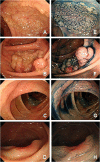Clinicopathological features of laterally spreading colorectal tumors and their association with advanced histology and invasiveness: An experience from Honam province of South Korea: A Honam Association for the Study of Intestinal Diseases (HASID)
- PMID: 28977010
- PMCID: PMC5627894
- DOI: 10.1371/journal.pone.0184205
Clinicopathological features of laterally spreading colorectal tumors and their association with advanced histology and invasiveness: An experience from Honam province of South Korea: A Honam Association for the Study of Intestinal Diseases (HASID)
Abstract
Background and aims: Laterally spreading colorectal tumors (LSTs) are divided into four subtypes, including homogenous (HG), nodular mixed (NM), flat elevated (FE), and pseudo-depressed (PD), based on their different endoscopic morphologies. The aim of this study was to investigate the clinicopathological significance of LST subtypes and their association with advanced histology.
Methods: We investigated the medical records of consecutive patients with LST who initially underwent endoscopic resection at five university hospitals in Honam province of South Korea between January 2012 and December 2013. A total of 566LST lesions removed via endoscopic procedures were collected retrospectively for data analysis.
Results: The PD, FE, and NM subtypes were more common in the distal colon and the HG subtype in the proximal colon. The PD subtype had the biggest tumor size, followed by the NM subtype. The frequency of adenomatous pit pattern was significantly higher in the HG, NM, and FE subtypes than in the PD subtype. In contrast, the frequency of cancerous pit pattern was significantly higher in the PD subtype than in the other three subtypes. The rate of advanced histology (high-grade dysplasia or carcinoma) among the LSTs was 36.0%. The risk of advanced histology increased in the distal colon compared with the proximal colon. The PD subtype had the highest incidence of villous component, advanced histology,submucosal invasion, and postprocedure perforation among the four subtypes. The distal colon as tumor site, larger tumor size, PD subtype, and villous component were associated with a statistically significant increased risk of advanced histology.
Conclusion: Our results indicate that the location, size, endoscopic subtype, and histologic component of the LSTs are associated with an increased risk of advanced histology. Therefore, these clinicopathological parameters may be useful in selecting therapeutic strategies in the clinical setting.
Conflict of interest statement
Figures

Similar articles
-
Clinical outcomes of endoscopic resection for colorectal laterally spreading tumors with advanced histology.Surg Endosc. 2019 Aug;33(8):2562-2571. doi: 10.1007/s00464-018-6550-0. Epub 2018 Oct 22. Surg Endosc. 2019. PMID: 30350100
-
Risk factors associated with clinical outcomes of endoscopic mucosal resection for colorectal laterally spreading tumors: A Honam Association for the Study of Intestinal Diseases (HASID) multicenter study.Turk J Gastroenterol. 2019 Apr;30(4):350-356. doi: 10.5152/tjg.2019.18393. Turk J Gastroenterol. 2019. PMID: 30945645 Free PMC article.
-
A long-term follow-up study on the prognosis of endoscopic submucosal dissection for colorectal laterally spreading tumors.Gastrointest Endosc. 2016 Apr;83(4):800-7. doi: 10.1016/j.gie.2015.08.043. Epub 2015 Sep 1. Gastrointest Endosc. 2016. PMID: 26341853
-
Non-polypoid colorectal neoplasms: Classification, therapy and follow-up.World J Gastroenterol. 2015 May 7;21(17):5149-57. doi: 10.3748/wjg.v21.i17.5149. World J Gastroenterol. 2015. PMID: 25954088 Free PMC article. Review.
-
Colorectal endoscopic submucosal dissection: Technical advantages compared to endoscopic mucosal resection and minimally invasive surgery.Dig Endosc. 2014 Jan;26 Suppl 1:52-61. doi: 10.1111/den.12196. Epub 2013 Nov 5. Dig Endosc. 2014. PMID: 24191896 Review.
Cited by
-
Serum Expression of β-Catenin Is a Potential Detection Marker in Patients with Colorectal Cancer.Dis Markers. 2019 Oct 24;2019:5070524. doi: 10.1155/2019/5070524. eCollection 2019. Dis Markers. 2019. PMID: 31781302 Free PMC article.
-
Current Trends in the Management of a Complex Polyp: Endoscopy versus Surgery.Clin Colon Rectal Surg. 2024 Jul 3;38(3):203-211. doi: 10.1055/s-0044-1787892. eCollection 2025 May. Clin Colon Rectal Surg. 2024. PMID: 40291994 Free PMC article. Review.
-
Endoscopic Management of Complex Colorectal Polyps: Current Insights and Future Trends.Front Med (Lausanne). 2022 Jan 20;8:728704. doi: 10.3389/fmed.2021.728704. eCollection 2021. Front Med (Lausanne). 2022. PMID: 35127735 Free PMC article. Review.
-
Long-term prognosis after treatment for T1 carcinoma of laterally spreading tumors: a multicenter retrospective study.Int J Colorectal Dis. 2019 Mar;34(3):481-490. doi: 10.1007/s00384-018-3203-7. Epub 2019 Jan 3. Int J Colorectal Dis. 2019. PMID: 30607579
-
Predictors for malignant potential and deep submucosal invasion in colorectal laterally spreading tumors.World J Gastrointest Oncol. 2022 Jul 15;14(7):1337-1347. doi: 10.4251/wjgo.v14.i7.1337. World J Gastrointest Oncol. 2022. PMID: 36051097 Free PMC article.
References
-
- Brenner H, Kloor M, Pox CP (2014) Colorectal cancer. Lancet 383: 1490–1502. doi: 10.1016/S0140-6736(13)61649-9 - DOI - PubMed
-
- Choi Y, Sateia HF, Peairs KS, Stewart RW (2017) Screening for colorectal cancer.Semin Oncol 44: 34–44. doi: 10.1053/j.seminoncol.2017.02.002 - DOI - PubMed
-
- Mahasneh A, Al-Shaheri F, Jamal E (2017) Molecular biomarkers for an earlydiagnosis, effective treatment and prognosis of colorectal cancer: Current updates. Exp Mol Pathol 102:475–483 doi: 10.1016/j.yexmp.2017.05.005 - DOI - PubMed
-
- Lambert R, Tanaka S (2012) Laterally spreading tumors in the colon and rectum. Eur J Gastroenterol Hepatol 24: 1123–1134. doi: 10.1097/MEG.0b013e328355e2d9 - DOI - PubMed
MeSH terms
LinkOut - more resources
Full Text Sources
Other Literature Sources
Medical

